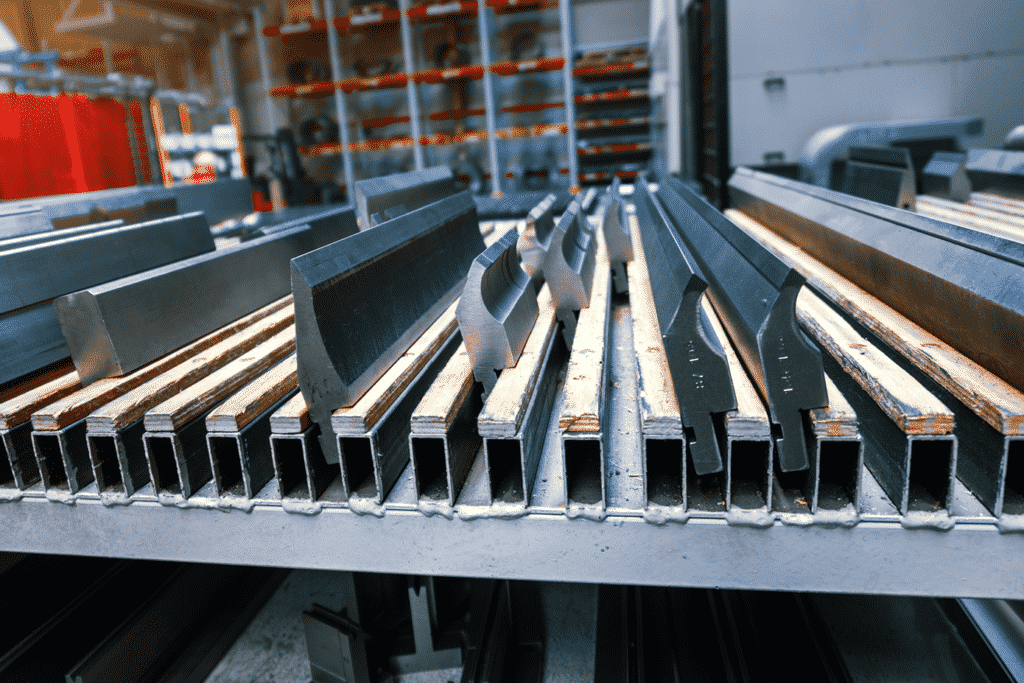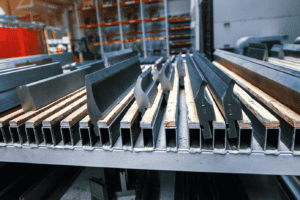Top tools and bottom tools, (punches and dies respectively) work in unison at the business end of your Press Brake. They work by folding your workpiece between a matching punch and die and applying force to bend the material (typically sheet metal and metal plate) in to a pre determined shape.
That principle is more or less the same across manual, hydraulic and CNC press brakes although each type of machine varies in terms of factors such as accuracy, automation, cost and power, they all rely on punches and dies or more specifically; the correct combination of the two to perform the often intricate bends you need.
Choose them wisely and you have excellent quality, accurate bends, a machine with a longer working life and a safe working environment. Get it wrong and any or all those things could be seriously affected. With that firmly in mind, we think it is worth having a more in-depth look at press brake toolings and how to choose the top tooling (or punches) and bottom tooling (AKA dies) for the task.
Top Toolings or punches
Press Brake punches come in a wide variety of shapes and sizes, which one you choose for any given job, will depend on the job itself. There is a vast range available, although they can be generally classified into three unique types, Goose Neck Punch, Swan Neck Punch and Acute Angle Punch. There are of course sub-divisions of these three types,with different radius on the nose to suit different material thicknesses and some can even be made specifically by us at Selmach for the more bespoke and unique tasks such as joggle and curl tooling. Knowing which type is best for which application can and will pay dividends.
The Standard Punch
A look at some of the most popular punches available has to start with one of the most widely used. The Standard Punch is a 1010 Goose Neck Punch which sees the lion’s share of use for most everyday bending tasks such as coining 90° right angled corners orair bending 135° angle (which together account for around 90% of all bending jobs). Standard punches are characteristically strong and stocky, making them ideal for thicker materials, higher loads and lengthy bending lines. They are a versatile, heavily relied upon and essential piece of kit.
The Acute Angle Punch
If you require sharper, more acute angles then the Acute Punch is the punch to choose. Acute is of course a definition that can mean different things to different people based on their needs or different jobs, so generally any angle between approximately 25° to around 60° could be classed as acute. Much like the standard punch they are stocky though more pointed at their tips and still capable of handling larger forces when combined with the correct die (bottom tooling). The radius 0.4mm will give 70T/m whereas a 6mm radius will give 100T/m.
The Narrow Punch
The Narrow punch is the master of tight spaces, in essence it fulfils much the same role as its standard and acute companions, but with one important difference; it is much narrower along its entire length. That gives the Narrow Punch the ability to perform final bends on workpieces where space is very limited such as 90° bends on material that has already seen some bending. The Narrow Punch is used less but when you need it, it is indispensable.
The Swan Neck Punch
Swan neck top tools are particularly useful for ‘U’ bend shaped brackets. Due to their unique shape they prevent the leg formed by the bend from colliding with the tool itself when performing the second bend. It is important to note though that the Swan Neck Punch does have limitations. If those ‘U’ profiles and channels that you need both have high sides, then the stocky nature of the punch and the fact that it widens towards its top end can mean that your punch and workpiece might come into contact with each other, impairing your bend and potentially damaging both your workpiece and machine.
Swan Neck Punches are very situational, typically sturdy but not as strong as other punches due to their uniquely angled shape and unsupported force line on the way to the workpiece.
The Joggle Punch
The Joggle Punch allows bends to be formed around corners. There is however an important difference in that the Joggle also has the thinner qualities of the Narrow Punch and Die along its shaft; that makes angular ‘S’ shaped bends and bending around existing corners much more feasible. Joggle Punches might be seldom used but just like Narrow Punches and Dies, when they are needed, they are priceless.
Radius Top Tooling
The radius top tooling can be quite useful to produce radius’s of different sizes. They can be used with different heights of top tool holders and different size radius. They can be used in conjunction different size bottom vees to produce the correct radius.
Bottom Toolings or Dies
Now that we have had a look at the various type of top toolings, it is time to turn our attention to Bottom Toolings (or dies). The first thing to note is that just like the top tooling; together they have a standard length of 835mm, broken into segments of specific and standard sizes just like the punches they work with (more on those ‘Standard Lengths’ later). They are also strong, typically crafted from materials such as T8 steel, T10 steel, and the more expensive Cr12MoV or 42CrMo for high strength, superior durability and the best possible resistance to wear and tear.
Dies also come in a wide range of types, from single Vee designs up to four, five and even six Vee versions as well as U bend and Z bend variants. Which you choose will depend on your fabrication needs but you also need to bear in mind the parameters of your Press Brake.
Single Vee Dies
Single Vee dies are the most commonly used, as their name suggests they possess a single ‘V’ shaped groove of varying angles with the minimum distance from the middle of the vee to the back of the tool to allow the minimum joggle available without crushing the tool.
Two-Way Self-Centring Vee Dies
Two-way Self-Centring Vee Dies have two successive grooves (typically of differing angles and/or widths) which give the operator the convenient potential of working continually without any need for retooling if your workpiece has different bend requirements. Additionally, with two grooves they are much closer to the sides of the die making shorter flanges a possibility.
Multi-Vee Dies
Multi-Vee Dies come in a wide variety of exotic shapes, containing 3, 4, 5 and larger; vees spread across their four sides. This gives impressive variety in terms of radii and material thickness you can work with. Although it is important to remember that rotating the die is vital in order to utilise a different vee. They are not always suitable for short flange bending either if the vee is in the middle of one side.
Flattening & Hemming Dies
Flattening and Hemming Dies, also known as Safe Edge, Dutch Bend and Hemming Dies are a simple and straight forward solution for finishing (or flattening) acute angle bends, not very exciting but very necessary when needed. There are two types, the sprung loaded bottom tool or the newer U section bottom tool.
Choosing the Perfect Pair
So now we know a little more about Top and Bottom Dies, but how do we know which is a suitable match for the other? There are many factors to take into account; factors such as the parameters of your Press Brake, parameters of your dies, maximum bending forces, material types, strokes…The list is long and you need to know your machine, your materials and your dies very well.
For the brave there are formulae; to work out die height, die point radii and everything else you need to know to ensure you’ve got it right and you do need to ensure you’ve got it right because getting it wrong can be expensive…
For the smart there is another option; call our sales team to discuss your requirements, supply some drawings and let our experienced engineers advise you on what you need. We supply a range of standard Morgan Rushworth Press Brake Tooling which can be viewed on our website on the Selmach Sheet Metal Press Brake downloads tab, as well as specially commissioned tooling for those more awkward shapes.
Tonnage calculations
Different tonnage is required for bending different materials and thicknesses safely and effectively. To ascertain the tonnage you need for the various bending operations you perform, refer to your tonnage calculator chart.
Down the left hand side of the table is the material thickness (T) in mm; across the top of the chart are your various internal bend radii (R), your minimum return bend (M) and your bottom die Vee width (V).
Our own table below also includes important information on tensile strengths of mild steel, stainless steel and aluminium along with a quick but vital formula for working out your own required minimum flange length, inside radii and the die width that is needed for each operation to ensure you are using the correct top and bottom toolings for the task in hand. Each and every task performed needs a certain tonnage per meter which is shown in the table below. As you can see the pattern is obvious; materials with greater thickness and more acute inside radii require more force in terms of greater tonnage to process your bends safely.
Standard Lengths
It is worth noting that both top and bottom toolings come in a range of standard lengths. It might seem like information you don’t really need however it can be very useful. Imagine you have a sheet of metal that is 2000mm in length; imagine also that it requires several small bends to be performed. Your cuts are already made in preparation for the bending process (let’s imagine they are 29mm), all the operator needs to do is perform the bend right?
Well yes, but is there a standard length tooling to match that exact length of cut? No…There may be a standard length 20mm punch and die and there may be a 40mm set which will of course be too large. The 20mm dies will be short, and that will impact quality of the bend as the dies that are being used will not be the exact length of the bending line.
Wherever possible always try to match your design to the standard lengths of the punches and dies available to you. At Selmach our standard lengths conform to the universal standards starting at 10mm then 15,20,40.50,100 (x2, Left & Right),200 and 300mm respectively, to give a total combined standard length of 835mm in any combination of the above lengths you might need.
So as you can see from all the information above, using your Press Brake is a relatively straight forward affair but using it optimally; to create the best possible work, delivered safely and all whilst prolonging the life of your beloved equipment depends largely on choosing the right toolings for the job. If knowledge is indeed power, then all the information and advice here should be enough to set you on the path to enlightenment.
For any advice on our range of Press Brakes, Punches, Dies and for information on those one-off bespoke toolings that we would be happy to craft for you, simply click, tap or call us on +44 (0)1432 346 580, email [email protected] or get in touch via our website.
Published 19th August 2019



